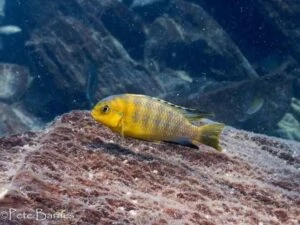Sciaenochromis fryeri
Sciaenochromis fryeri was only described for the first time in 1993 by Ad Konings. His name can be divided into Sciaena which means Sea in Latin, Chromis means color in Latin but refers to colorful saltwater fish. The species name fryeri refers to Geaffrey Fryer. The name loosely translates to something like “colorful like sea fish named after Geoffrey Fryer.”
Synonyms: Cyrtocara ahli, Haplochromis ahli, Sciaenochromis ahli, Haplochromis jacksoni.
The species was previously often confused with Sciaenochromis ahli. This variety is less deeply colored metallic blue and is almost never offered.
Description
The most striking thing about the Sciaenochromis fryeri is the shiny metallic blue color of the males. The southern populations are characterized by a beautiful white stripe that runs from the lips to the tail fin. Most males from Likoma Island lack this white stripe but have a more intensely red colored anal fin.
Like many other Malawi cichlid females, the females remain a somewhat dull brown/gray. Because breeding males are not too aggressive and do not constantly chase after the females, you can suffice with 1 male and 1 female. This contrasts with many other species where you often must keep more females than males. This is slightly different with wild-caught males, they are more aggressive and need several females to distribute the aggression among the females.
In the wild they do not grow much larger than 12 to 15 centimeters, but because we feed them a little more in the aquarium, they can become a bit longer and taller. The males can then grow to about 20 centimeters.
Biotope
This species has never been found in large numbers but is found throughout Lake Malawi. The first exported specimens were caught at Maleri Island and Cape Maclear, but since a fishing ban has been imposed here, most Fryeri now come from Likoma Island and the surrounding reefs.
They inhabit the rocky coasts and the transition zones from rock to sand.
Diet
This species is a real fish eater in the wild, hunting very small Mbuna and Copadichromis. In the aquarium, you can feed them with various frozen foods such as mysis, artemia, small pieces of fish, mussels, chopped shrimps, etc. They also accept dry food such as flakes and pellets. As with all other Malawi cichlids, it is better not to feed them tubifex.
The Aquarium
An aquarium of about 150 centimeters and 400 liters is large enough for the Sciaenochromis fryeri. You can keep one male with one or more females.
The aquarium can be decorated as usual for a Malawi aquarium. There is sand on the bottom, interspersed with stones and rocks. Make sure there are enough hiding places for the female to hide. They also need a lot of swimming space.
Sciaenochromis fryeri likes very clean water, so ensure regular, large water changes and a filter that is more than sufficient for the size of the aquarium.
The Spawn
In the wild, the male makes a large breeding pit in the sand, often near an overhanging rock. There is not enough space in the aquarium, so he makes a shallow breeding pit somewhere. He lures the female with trembling movements. While circling each other, the female lays her eggs in the breeding pit, and the male circles with her and fertilizes the eggs. While circling, the female takes the fertilized egg into her mouth to incubate it. A clutch can consist of a maximum of 30 to 50 eggs.
During incubation the female does not eat at all. You can clearly see from the throat pouch that she has eggs in her mouth. Usually the first clutches are smaller than when she already has a lot of experience. In a female with a lot of experience, the mouth is so full that the young are sometimes clearly visible if you look closely.
Raising the fry
Mouthbrooding females hide between rocks and release their young after 3 weeks. If you want to let the young grow up, you can catch the female around day 18 or 19 and place her in a small aquarium. The female shows no interest in the young for the first few hours after release and will probably not take them back into her mouth again. After releasing the fry, you can place the female back in your regular aquarium. It is preferable to first give her two weeks of rest to gain strength in a separate aquarium without males.
If there are many hiding places in your regular aquarium in the form of rocks that are small enough for the young but too large for the parents, then a few young may survive from each nest. You can feed the fry with crumbled flake food or brine shrimp.
The males only get their first blue color when they are about a year old.
Conclusion
It is a small, slender predator that can also be kept with the calmer species due to its calm behavior. The color of the male is a real eye-catcher, especially if he is feeling good and is fed a good varied diet.
Video
Author
John de Lange
Copyright images
Malawi’s Unlimited
John de Lange
Sources:
Datz 09/2001 pagina 13 Aquarien Praxis
Fishbase.org
Seriouslyfish.com
Aquamalawi.com











































Reviews
There are no reviews yet.